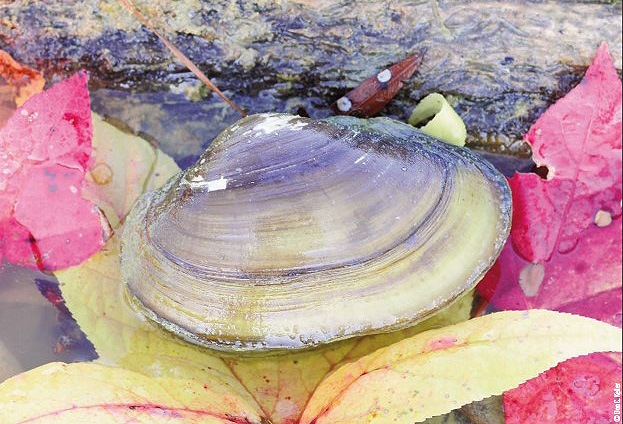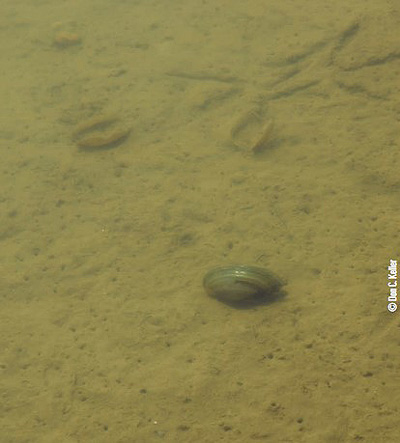Don C. Keller, Certified Fisheries Scientist | Originally published in GameKeepers: Farming for Wildlife Magazine

“My pond has a lot of these clam shells around the edges. Where did these come from and are they going to harm my fish?” We get calls similar to this several times a year from pond owners throughout the southeast. These shells are freshwater mussels and although there are hundreds of species, only a few are adapted to pond environments. The most commonly asked question is how do the mussels get in my pond? Do raccoons bring them or do they attach to the feet of wading birds? Although mussels provide a food source for wading birds, raccoons, muskrats and otters, they are not responsible for their transport. Fish are responsible for their distribution.
Mussels are often labeled “hitchhikers” as the larval form of the mussel, called glochidia, attach to a host fish and move from one location to another. During large rain events, host fish will travel out of a pond containing mussels, through the spillway and downstream to another pond. Conversely, infected fish may travel up the watershed and over the spillway of a pond above. The glochidia may stay attached to the fish for weeks or months before it develops to a stage where it will leave the fish and drop to the pond bottom. We will explain in detail how this occurs.
Common Species of Pond Mussels
Three of the most common pond mussels are the Giant Floater, which can attain sizes up to 10 inches, the Paper Pondshell, which is usually 2 to 4 inches and the smaller Liliput which is often less than 1.5 inches in total length. All of these mussels function in similar ways. They propel themselves across the pond bottom with a muscular appendage called a “foot”. In shallow silt or sand bottoms it is possible to see the trail left by the mussel pulling itself across the pond bottom with its foot.
Mussel Food
Mussels are filter feeders, dining on phytoplankton and fine decaying organic matter. They suck water in across a set of gills by an “incurrent siphon” and expel the filtered water through a separate “excurrent siphon”. These tubes are not really siphons but more like muscular pumps. Although mussels are filter feeders, they are not likely to be in high enough densities to significantly affect the phytoplankton bloom. If your pond is clear it is unlikely the result of mussels filtering large amounts of phytoplankton, even though larger mussels are capable of filtering up to 40 liters of water an hour.
The invasive Zebra mussel is credited with clearing many areas of the Great Lakes; however, their densities are thousands per square foot. Their densities in some areas of the Great Lakes are so high they are basically stacked on top of each other. This exotic invasive mussel, thought to have arrived in the Great Lakes by hitchhiking in the ballast water of international ships, is causing great concern.
Reproduction
According to Mr. Jeff Garner, mussel expert (Malacologist) with the Alabama Division of Wildlife and Freshwater Fisheries, some mussels such as the Paper Pondshell may become sexually mature and gravid as small as one inch. Reproduction in this species is not seasonal or temperature dependent and some members of the population are probably reproducing at any given time. Giant Floaters and Lilliputs are more seasonal in their reproductive habits and are generally gravid from fall to the following spring or early summer. Sexually mature males expel sperm through their excurrent siphon. The sperm are sucked in by the female through the incurrent siphon and eggs are fertilized internally. The eggs are held in special compartments of the gills and develop into the larvae (glochidia). When the glochidia are fully formed they are released into the pond and must attach to a fish to complete their development.

Some mussel species require particular fish hosts for their glochidia to develop. Common host fish include green sunfish, bluegill, crappie and bass. Also, glochidia from different species of mussels have specific attachment sites on their host fish. Some attach to the gills while others attach to the fin rays or the body of the host. These appear as a tiny white dot on the fins and can be seen with the naked eye. The glochidia become encapsulated on their attachment site and will remain on the fish until they mature and drop to the pond bottom as a tiny mussel. These mussels may find themselves in a new location, depending on how far their host has ranged. The tiny mussels are then vulnerable to predation by redear sunfish, which are adapted to eat various mollusks such as snails and mussels.

mussel is typically 2 to 4 inches in length and has a green
color. Notice the foot prints of wading birds and the empty
mussel shells.
Many of the mussels are long lived, with life spans of 50 years or longer. However, pond mussels have a much shorter life span, some not living more than 5 years.It is common to see open mussel shells along the shoreline where raccoons or muskrats have eaten them. If you look carefully in the shallow water you may see a live specimen or many live mussels.
Wading birds often leave their tracks among the empty shells of the shallows, indicating heavy feeding among the mussel population.
Some ponds are unlikely to have a mussel population. Ponds and lakes with a small watershed, where water seldom goes over the spillway and ponds without a mussel infested pond in the upper watershed are not likely to develop populations of mussels. It will be very unlikely for a host fish to access these ponds. Although mussels are often thought of as a biological indicator of good water quality, if you do not have mussels in your pond it is more likely that a host fish has not found you.
Mussels do not cause any significant problems for your pond. They will provide opportunities for a variety of wildlife to visit your pond. Mussels are not a primary host for fish parasites like snails are and will not affect your fish in that manner. Be careful wading barefoot in your pond if you have mussel shells they can cause cuts!






























